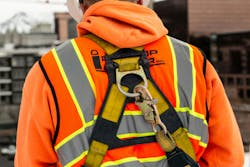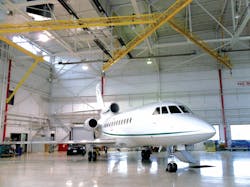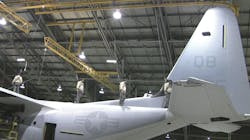Providing Fall Protection for Aircraft Maintenance in Extreme Cold Conditions
Key Highlights
- Properly fitting fall arrest harnesses are crucial for effective fall protection and compliance with OSHA standards, especially when workers wear bulky winter clothing.
- Employers should utilize indoor facilities, overhead anchorage systems and mobile fall protection anchors to reduce slip and trip hazards during winter months.
- Regular training, equipment inspections and program reviews are essential to adapt fall prevention strategies to winter conditions and ensure worker safety.
According to the U.S. Bureau of Labor Statistics (BLS), 450,000 worker injuries annually are caused by falls, with nearly 10% of those falls directly related to snow, sleet or icy conditions.
Colder temperatures and increased precipitation during the winter months bring unique challenges for certain aspects of an aviation MRO’s safety management systems or programs. Precipitation can lead to slippery surfaces and an increased chance of workers slipping, tripping, or falling.
Falls at the same level and falls to lower levels cause fatal injuries among 800-1000 workers annually, according to the Occupational Health and Safety Association (OSHA).
Falls are preventable, but workers can be kept safe by considering and implementing:
- Appropriate training
- Correct equipment
- Efficient and accurate procedures
Fall protection equipment can help save lives when accidental falls occur in the repair shop, on the tarmac or in the maintenance hangar. While maintenance organizations should always implement robust fall prevention methods, like guardrail and secure maintenance access platforms, fall arrest equipment is also effective at preventing fatalities.
This article will discuss what fall-protection challenges can arise during the winter months and how aircraft maintenance employers can keep their workers safe all year round.
What are OSHA Fall Protection Requirements?
The Occupational Safety & Health Administration (OSHA) General Industry 1910 standard requires employers to provide fall protection any time a worker is exposed to a fall of four feet or greater.
- Measures recognized as acceptable fall protection include:
- Safety netting
- Guardrail
- Personal fall protection systems
OSHA relies on employers to determine which fall protection methods are the most feasible, practical and effective in protecting their workers from the unique fall hazards associated with their facility.
Why Proper Harness Fit is Important
Workers using fall arrest equipment must be properly fitted into their body harness before beginning elevated work operations.
In fact, OSHA requires workers to perform visual inspections before each use to ensure proper fit & function. Employers must train employees to inspect their harnesses for damage or defects and ensure a proper fit every time they don the protective equipment.
Fall protection harnesses are available in multiple sizes to accommodate users from 130 pounds to 420 pounds. They contain at least five points of adjustment, in accordance with the ANSI Z359 Fall Protection Standard, so employers must train their workers to adjust their harnesses for proper function.
Fall protection harnesses that are properly adjusted fit snugly, but not too tightly. Shoulder & chest straps should be tensioned to ensure the dorsal d-ring is brought to an optimal position beneath the user’s neck and between their shoulder blades (see Graphic A above).
Leg straps should be tensioned to ensure they remain stationary during a fall. Leg straps should be tight enough so the user can pass their flat palm under their harness, but they should not be able to pass their fist. This is a fit method referred to as “flat hand, not fat hand.”
How Bulky Clothing Affects Harness Fit
In colder months, users must ensure they readjust their body harness to accommodate for winter apparel or other protective gear.
Fall protection harnesses must be worn over any outerwear to maintain constant access to the dorsal D-ring, which connects the user to their anchorage. When harnesses are too tight, workers can be tempted to remove the harness and perform unprotected elevated work, which can lead to disastrous results if a fall occurs.
If an employee’s harness cannot be adjusted enough to accommodate the outerwear, a larger sized harness should be provided for the employee to ensure they have properly fitted protective equipment.
How Accidental Slips and Trips Lead to Fatal Falls
When precipitation is forecasted, employers should attempt to move all tasks indoors to decrease the chance of smooth aircraft surfaces becoming even more slippery for workers.
Despite these efforts to keep surfaces dry, aircraft can be difficult to maintain even under perfect weather conditions. When a task exposes a worker to a fall hazard of four feet or more, the employer must provide some form of fall protection to ensure the worker’s safety.
Indoor facilities can utilize overhead anchorage systems (see Graphic B) to protect workers against slips or trips that accidentally lead to falling off the aircraft. Once a fall occurs, a self-retracting lifeline (SRL) will do the following:
- Catch the worker
- Absorb their excessive fall forces
- Suspend them off the ground until rescued by their crew
Overhead anchorage systems are ideal for this type of work, as they allow the braking mechanism in the SRL to activate almost immediately after a fall occurs. The higher the anchorage system is located, the more effective the fall protection system will be in preventing injury.
When facilities do not have permanent overhead anchorage systems installed, temporary options are available to employers. Mobile fall protection anchor systems (see Graphic C) offer overhead anchorage locations for SRLs and can be transported around easily to accommodate most aircraft.
Why Use MEWP Fall Protection?
Many workers prefer to work from mobile elevated work platforms (MEWPs) when performing aircraft maintenance. Federal OSHA does not require fall protection in non-articulating MEWPs, like scissor lifts, but many manufacturers now include anchor points on platforms for workers to use voluntarily.
If utilizing an anchorage located at or below the dorsal d-ring on their fall protection harness, workers must ensure they use a Class 2 SRL, which is designed for anchorages located at or below the dorsal d-ring on their fall protection harness. Class 1 SRLs are only intended for overhead anchorage use and could potentially sever or malfunction when used with anchorages beneath the user’s dorsal d-ring.
The risk of falls is preventable year-round, but special conditions that arise in winter give MROs and repair shops a chance to review the effectiveness of their fall protection programs. Continuously improving these programs over time can help increase effectiveness and promote user compliance.
Safer workers are happier workers, and happier workers are more productive workers. Companies like Diversified Fall Protection can help design proactive fall protection solutions that can be adapted to the most unique fall hazards and provide safety anywhere—inside or outside—to any facility.
About the Author

Philip Jacklin
Philip Jacklin is continuing education program manager for Diversified Fall Protection. He is an AIA continuing ed provider, QSSP certified, OSHA-30 trained and has been a partner to the fall protection industry since 2018. Jacklin has a background in worker advocacy, team leadership and fostering camaraderie among peers. He enjoys playing music, writing and spending time in the sunshine with his family in Virginia Beach, VA.



